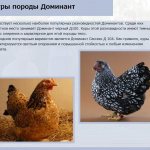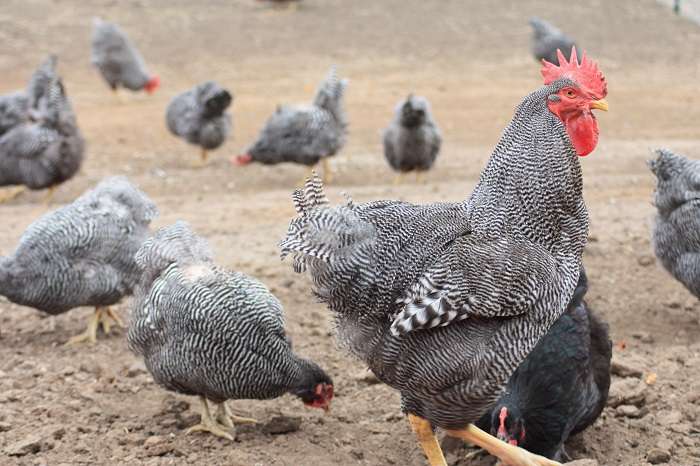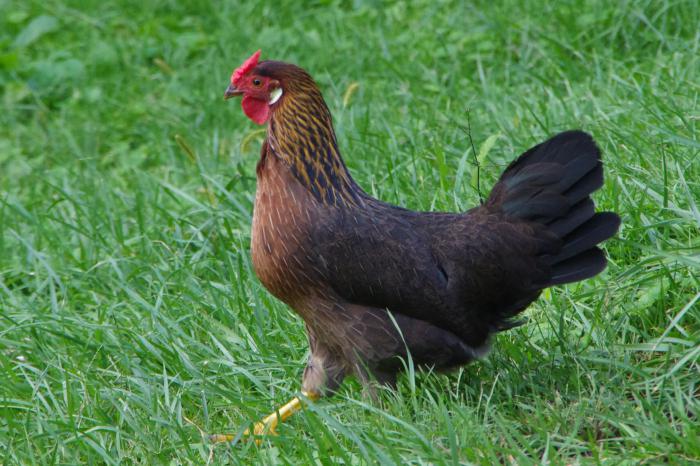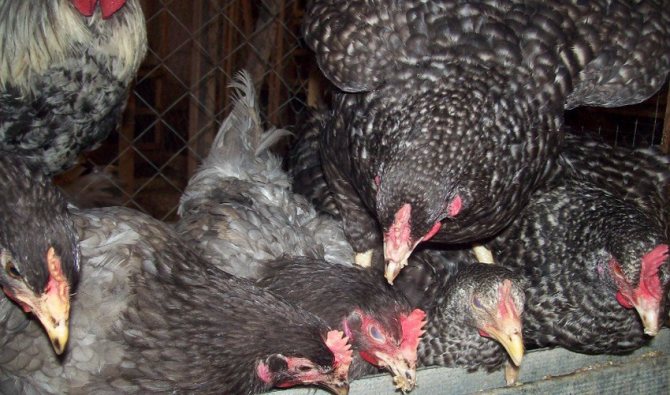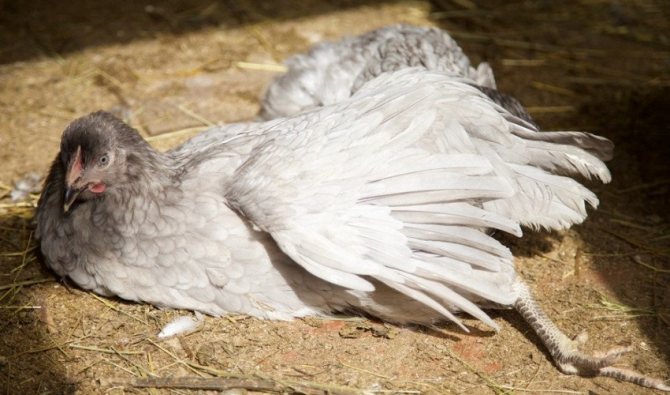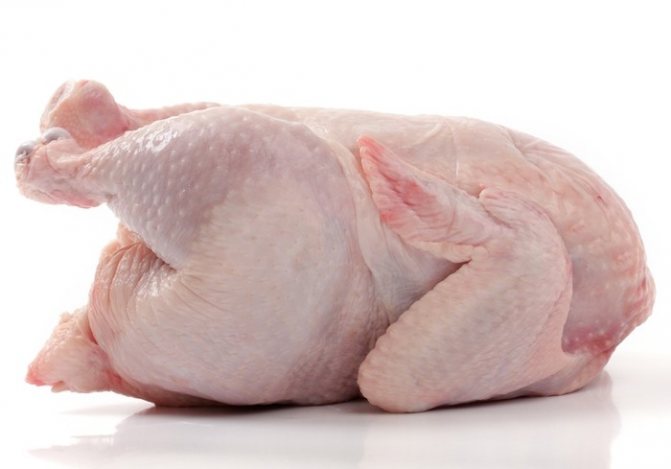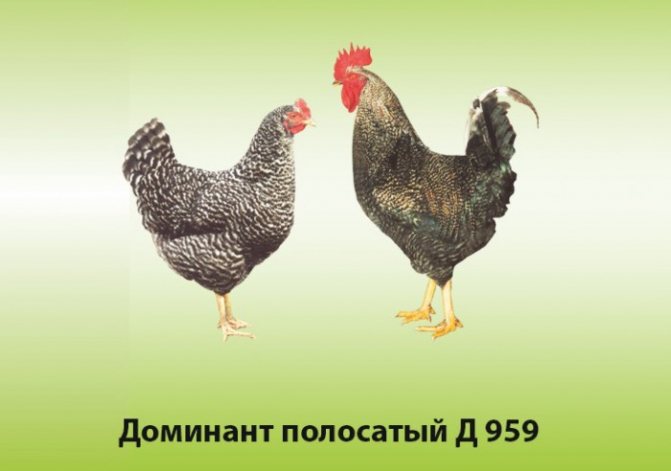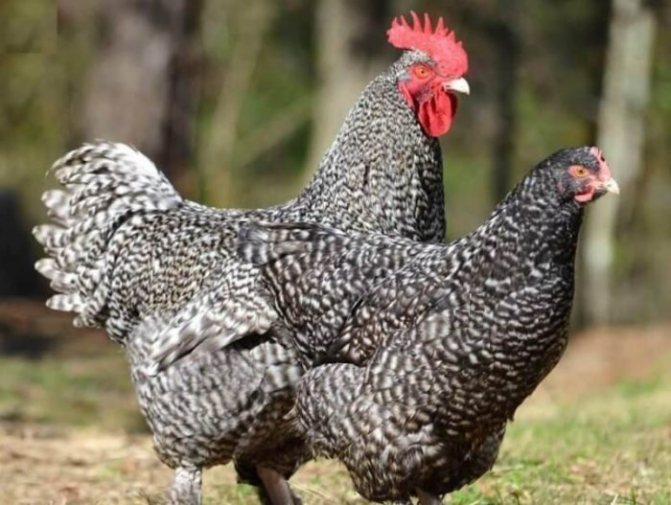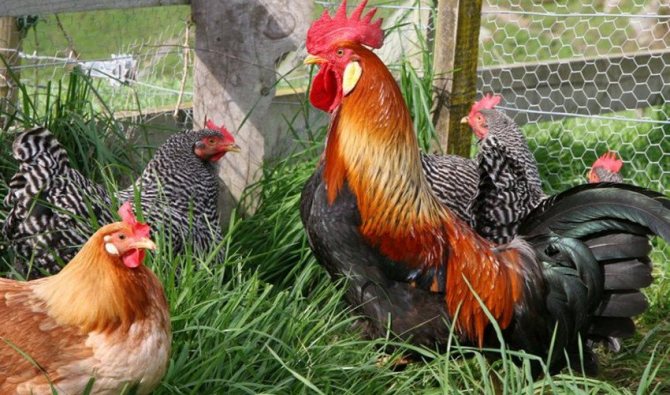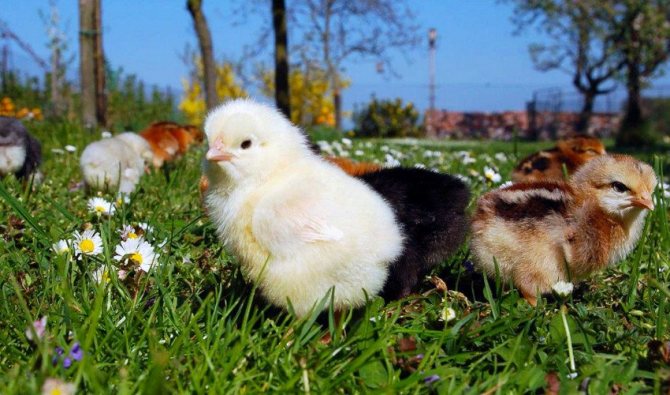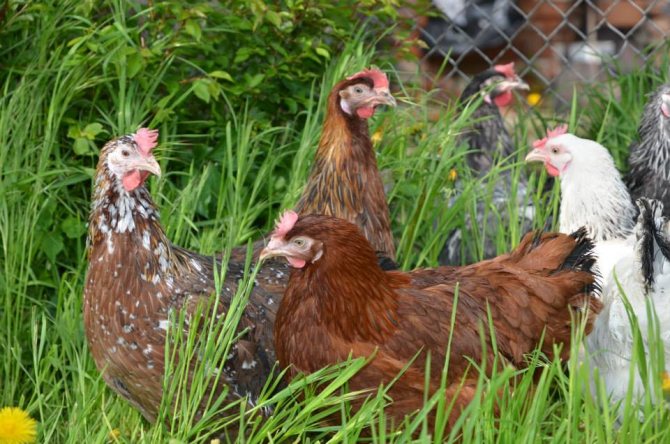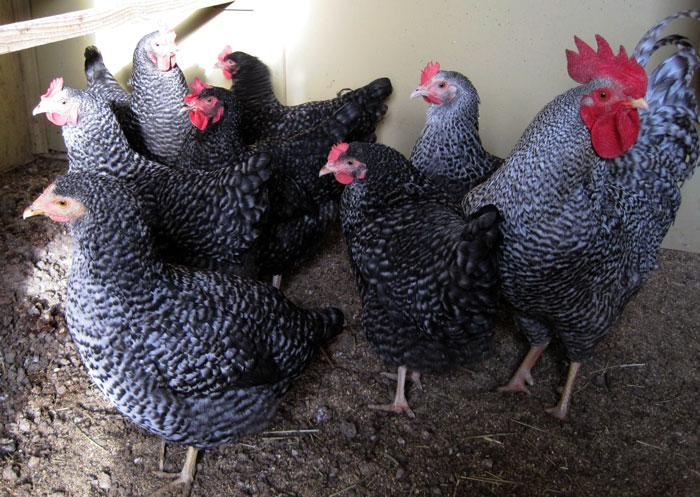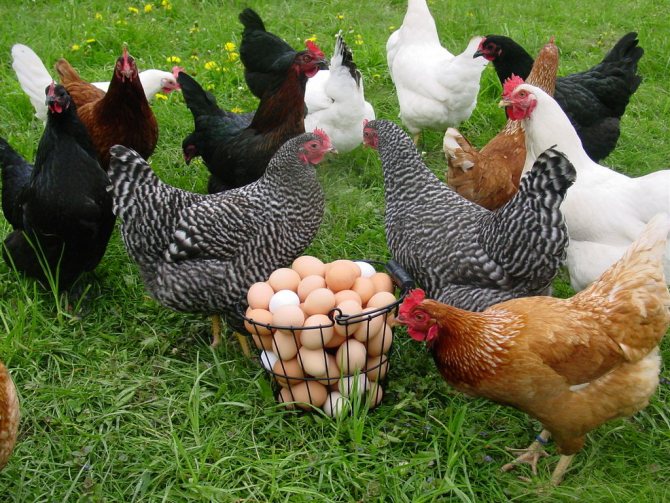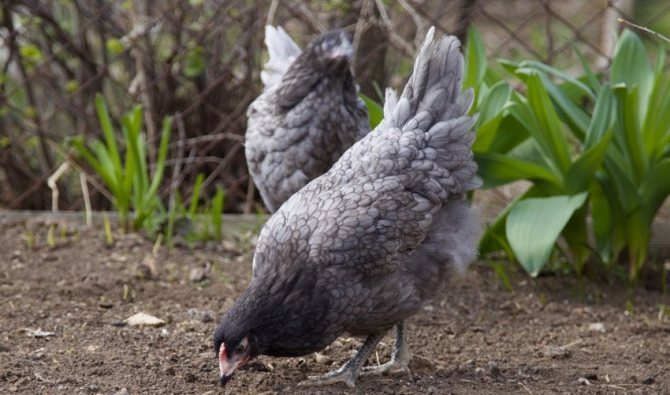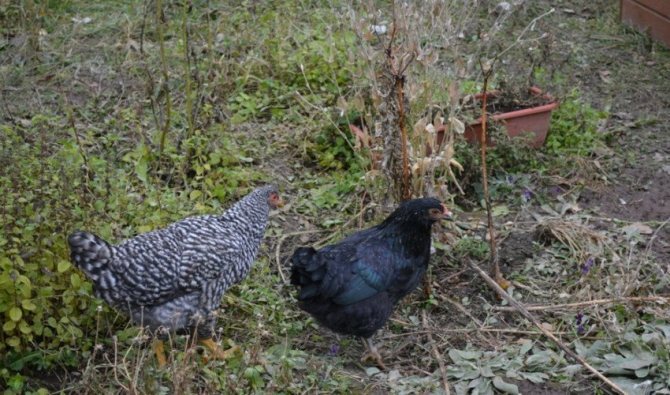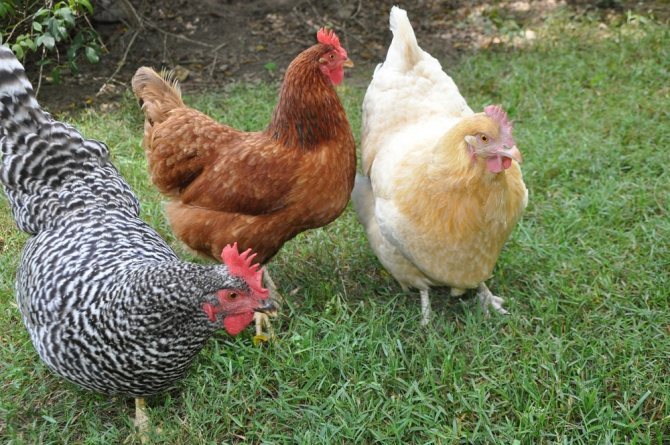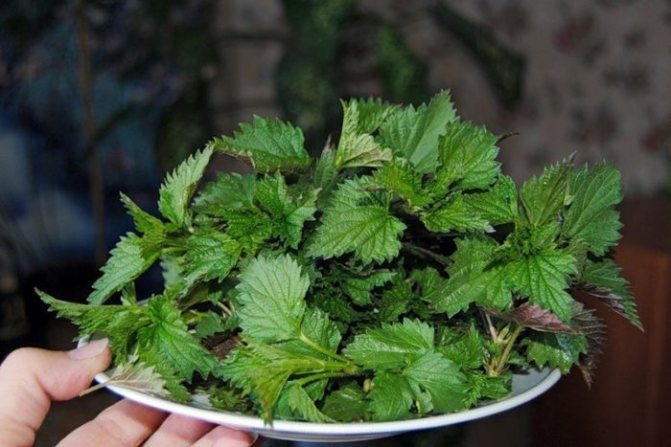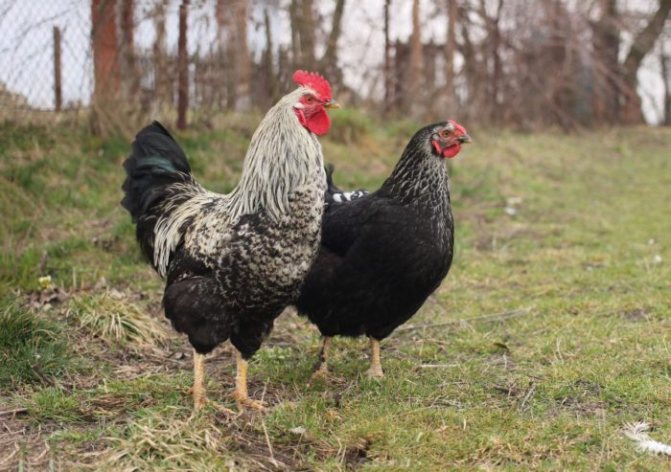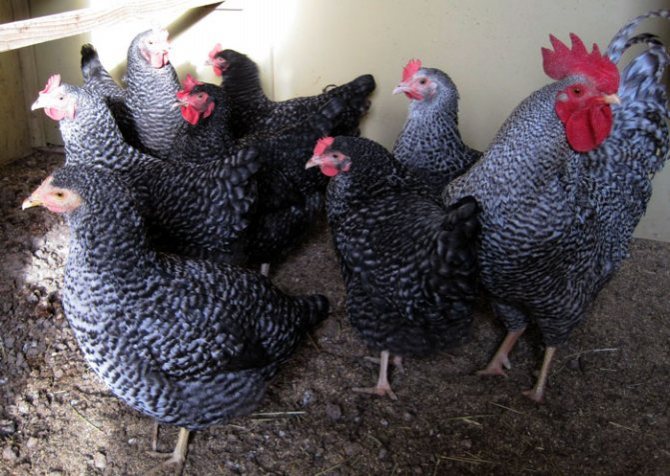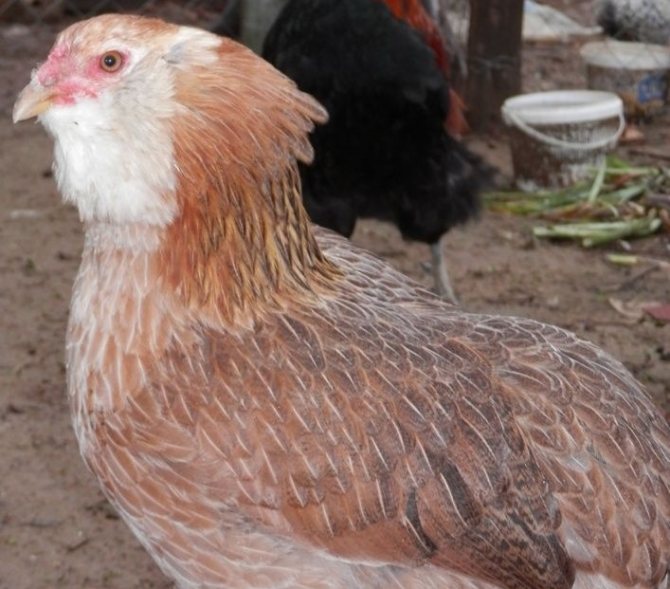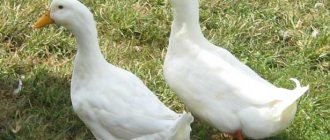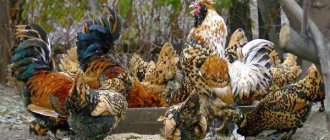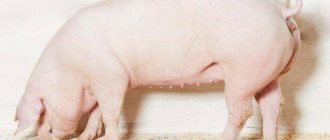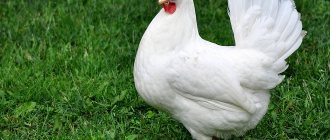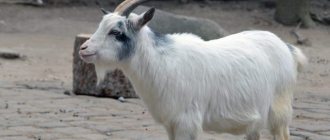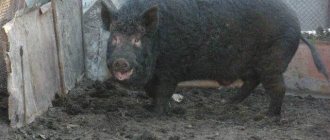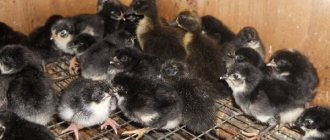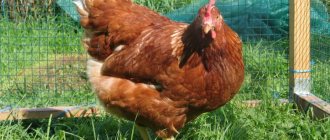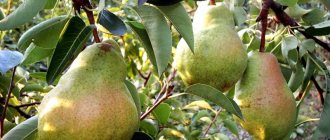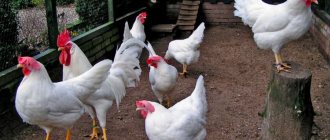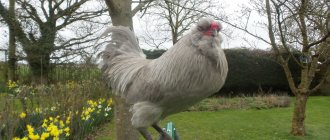Characteristics of a highly productive egg breed of Dominant chickens
Poultry farmers, residents of rural areas, the breed of dominant chickens has long been known. This type of poultry is notable for the fact that it is completely undemanding to the conditions of detention, has a calm disposition, and is also immune to many diseases. Dominant chickens have practically no flaws, and in many respects they have a great advantage over other egg-laying chicken breeds. The dominant was bred by Czech breeders in the small village of Dobrzhenice. But today the bird is bred in more than thirty countries of the world, having appreciated the merits of this breed. The dominant is popular not only in Europe and the post-Soviet countries, it is grown in the USA, South America, Asia.

Breeding various hybrids of chickens, breeders want to achieve the best breeds that will have high egg production, unpretentiousness to keeping conditions, and immunity to various diseases. After all, if chickens die en masse, then farms are deprived of meat and eggs for a long time. And when the breed of chickens is unpretentious to food and living conditions, it can be raised even by those who cannot provide the bird with special feed and create certain conditions for it. Just the dominant belongs to such unpretentious breeds. Chickens of the dominant breed are considered today the best laying hens for keeping in order to obtain eggs and, moreover, have very tasty, tender dietary meat. Bird characteristic:
- Laying hen lays up to 300 eggs per year;
- Egg weight is on average 70 grams;
- The survival rate of young animals is 95–97%;
- The mass of a chicken is up to two and a half kilograms, a rooster is up to three;
- Average feed consumption per animal is 140-150 grams;
- Good disease tolerance, high immunity.
Appearance and color of color cross
The dominant is a hybrid. There is more than one type of dominant, and their appearance may differ. This is especially true for the color of feathers. But there are signs that unite them:
- Small head, dense body of relatively large size with well-developed muscle mass;
- The wings of both chickens and roosters fit snugly against the body. The plumage is dense and dense. Due to which the birds seem even larger;
- The crest is scarlet, the earrings are bright red;
- The paws are colored in shades of yellow. Thighs are fleshy and well defined;
- The eyes are orange.
After the birth of chickens, you can immediately tell where the hen is and where the cockerel is. Those with a darker color - chickens, lighter - as a rule, cockerels.
Character: how to determine in advance
The calm disposition of the Dominant chickens, and Rhode Island is undoubtedly a great asset. They are not aggressive and this is extremely beneficial for poultry farmers. Such a calm behavior of the bird plays an important role in their breeding. They feel good being outdoors, in an open space. And in a room where there is sometimes a lot of overcrowding, they behave calmly and get along well with each other. Of course, keeping birds in close quarters all the time is not the best option. It is ideal to raise chickens when they have the opportunity to walk. If there is not enough space for the territory that can be fenced off, it is recommended to keep the birds in low enclosures. The bird should receive sunlight. It helps to synthesize vitamin D. Dominant chickens do not conflict with other birds, do not try to take food, but calmly wait for their turn. The black appearance of this breed is the best at adapting to new conditions of detention. Dominant hens are always calm, non-irritating, but roosters sometimes exhibit aggressive behavior.
But what is a rooster in a hen house for? This article will help you find out.
Appearance
Dominant hens and roosters give the impression of very dense and very large birds. In fact, males weigh 2.5-3.2 kilograms, and blackbirds - 2-3 kilograms. That is, the Dominants are not that impressive in size. But visually, they are given volume by dense plumage, tightly fitting to the body. Feathers of chickens are of medium hardness, on a downy basis. The coloration is varied, in total 12 types have been bred.
Other exterior signs:
- squat physique;
- pronounced muscle mass;
- low belly;
- fleshy thighs;
- short legs with bright yellow or orange skin;
- widely spaced paws;
- small wings;
- small head;
- small scarlet scallop;
- bright red earrings;
- orange eyes.
There are no special details in the appearance of the chickens, but in general they look very attractive. Farmers love to start them even for the purpose of decorating the poultry yard. This is especially true of the Blue Dominant breed.
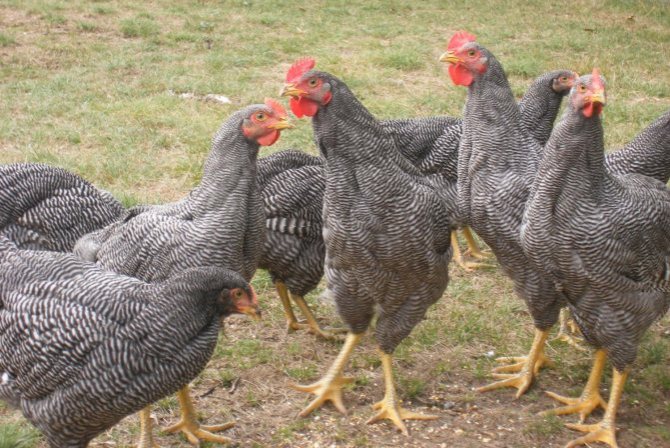

Shoes for private households
On the basis of dominant chickens, new subspecies were bred, which differ in external characteristics, productivity, feather color. The general advantages of crosses are:
- High egg production;
- Adaptation to various conditions of detention;
- Good tolerance to low temperatures;
- Resistance to various kinds of diseases.
Farmers who started breeding dominants will never change them to any other breed and always respond positively about them
Dominant gray-speckled-959
Dominant gray-speckled is recommended to be bred on small private farm lands. The color of this species of chickens is cuckoo. The plumage is black and white. The bird is able to quickly adapt to cold climates and is not susceptible to many diseases. Laying hens can lay about 300 eggs during the year. Each weighs up to 65 grams. The egg-laying period lasts on average up to 78 weeks, during which the chicken gains about 2, 15 kg of live weight. The bird has a calm disposition, easily gets along with other representatives of birds.
Black D-109
Black dominant D-109 very rarely get sick, are endowed with high immunity, therefore, the survival rate of chickens is very high and indicators of further viability can reach 99%. The plumage of both females and males is black, catkins and scallops are bright, scarlet. In chickens the dominant black cross D-109 has a very well developed maternal instinct. This subspecies of laying hens is sensitive to hatching young offspring, unlike some other breeds, the breeding of which is almost impossible without an incubator. A chicken can lay 300-315 eggs per year. Chickens of this subspecies are absolutely not shy, have a calm character, quickly get used to people and make contact.


The weight of the female reaches two kilograms, the rooster is up to three.
Blue D-107
The dominant blue hybrid D-107 has not only high egg production, but also a very effective plumage color. Chickens of this subspecies are raised in ecological farms, private household plots for the production of eggs. Poultry farmers have long fallen in love with this type of chicken for its high egg production rates. On average, a hen lays 300 brown eggs. This subspecies adapts well to low or high temperatures, as well as to various conditions of poultry farms and household plots. These birds are also bred on an industrial scale in African countries. In hot climates, the dominant blue feels great, unlike some other chicken breeds.The sex of the chicks can be distinguished immediately after birth. The males are striped with a white speck on their heads, the females are dark without a speck. The blue D-107 resembles the long-known Andalusian breed.
Partridge
The plumage of the dominant partridge resembles the plumage of wild birds. This subspecies of chickens has become popular due to the beautiful color of the feathers. Shimmering with golden, brown colors, it looks like the plumage of the Italian gold breed. A hen can lay 250-270 eggs per year, which is a relatively low figure. Partridge chickens are often bred for aesthetic pleasure, like ornamental birds.
Sussex
Chickens of the Sussex subspecies are white in color with a dark color of the tail and head. The survival rate of young individuals up to 18 weeks is quite high and amounts to 95–98%. Birds grow rapidly and gain muscle mass. A half-year chicken weighs 1.5–1.7 kg. Providing the Sussex with a nutritious diet can produce 300–310 eggs per year with brown shells. The peak of bird productivity is reached by 18 months of age. Sussex is often bred in cold climates due to the fact that chickens of this subspecies are resistant to low temperatures.
Also read about the Velzumer breed of chickens here.
Breeding difficulties
Many breeders have started to breed dominants on their own. Some of them are faced with the fact that the brood hen does not want to patiently sit on the eggs and leaves the nest before the chicks hatch.
Unfortunately, the dominants are chickens that do not have a highly developed maternal instinct. The exception is brood hens of the black subspecies D 109, who are anxious about hatching offspring.


Success in breeding chickens depends on who is bred: breed or cross. In the latter case, the offspring will not retain parental qualities, and productivity will drop.
To maintain the purity of dominant breeds, it is recommended to purchase chicks or hatching eggs from reputable suppliers. And also in farms or in specialized stores that have proven themselves well in the regional market.
Productivity: how it can differ from others when they start to rush
Dominants are chickens of the egg direction. The weight of the female can be 1, 8–2, 4 kg, of the male up to 3 kilograms. Laying hens begin to lay eggs quite early, from 4-5 months of age. Average egg production is 310-315 eggs per 365 days. The weight of each is 60-70 grams. There are often exceptions - eggs weighing up to 118 grams. They are not suitable for incubation, as with two yolks.
The appearance of Czech beauties is quite varied and depends on the parental lines. Chickens can also distinguish females from cockerels. As a rule, females are dark and males are light. If the color of the chicks is the same, then the males have a light speck on their heads. The sex of some cross-chicks can also be distinguished by the feathering of the wings. Chickens fledge earlier than males, so the latter's wings look as if they were slightly cut off.
Shell brown
Egg shells can be brown or white. There is an opinion among consumers that the darker ones are always homemade, and the whites are "incubator". This is not true. There is a definite connection between the color of the plumage and the color of the shell. Therefore, the color of the shell of this breed of chickens will be different. So crosses D 104, D 107, D 300 have an outer hard shell of an egg of cream shades, for all the others it is brown. Except for the Leghorn cross.
This corresponds to the color of their plumage, but contradicts the widespread opinion among amateur poultry breeders that the conditions of keeping and feeding laying hens will affect the color of the eggs. But at the same time, they can change the pigmentation of their outer hard shell for a while:
- A stressful situation that occurs a few hours before laying;
- The use of certain medications.
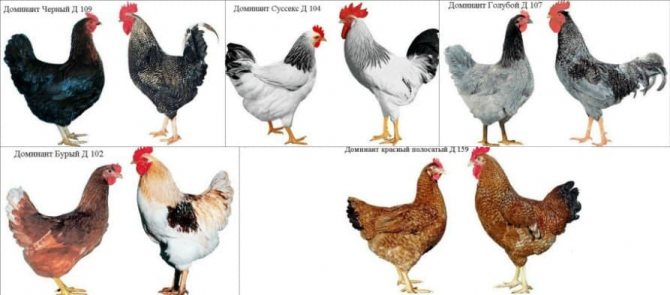

The dominant has different subspecies, in which the plumage is different.
Shell white
The productivity of a particular breed of laying hens does not depend on the color of the shell. White plumage means that the color of the outer hard shell of the product will be white and vice versa. More often than others, the white variety of the dominant breed is found in household farms. Females have good early maturity and they begin early laying at 5 months, continuing to rush continuously for about a year. Average annual egg production is about 300 eggs. Their weight ranges from 62 to 70 grams. But what some poultry breeders don't like is that individuals of this cross are usually bad hens.
Read why chickens peck eggs here.
Popular lines of dominants with white eggshells
Leghorn D 229, famous for its snow-white plumage and high productivity, is the most famous among the dominants producing white eggs. And the dominant partridge D 300, pleasing to the eye with bright feathers. Its characteristics are given in the article "Chickens dominant at number 300".
Layers Sussex D 304 also give cream testicles. They have white plumage with black blotches on the neck and tip of the tail.
Dominant D 301 also bears white eggs. These beautiful tricolor chickens appeared in Moscow recently, but have already aroused genuine interest among poultry farmers. And why, you can find out in the article "About chickens dominant D 301 tricolor".
Relatively recently, the cross dominant stained D 723, which has persistent immunity and high productivity, was also bred. The egg shell is creamy.
Egg production table of dominant hens laying white eggs:


The content of the dominant cross in cellular conditions
This breed of meat and egg direction is often bred at home in order to save money. They consume a small amount of food, moreover, they are completely picky about food. These birds are popularly bred in cold or hot climates where other chickens cannot survive normally. To arrange the territory for walking, dominants do not need high fences, they will not fly over fences. In addition, they can be bred both in large rooms, fences, and in small cages. The birds are rather calm in nature. Dominants can withstand both extremely low and high temperatures, moreover, they feel pretty good.
Dominants are not picky about conditions of detention, to walking. But if there is such an opportunity, you should not keep the birds locked up. They can get a lot of vitamins and nutrients for themselves, digging in the ground and eating green grass, worms and insects. Being under sunlight, the bird receives vitamin D to the full, and, accordingly, egg production rates increase.
Chicks: a description of what a chick should look like
It is advisable to purchase chickens from a reliable supplier or from specialized poultry farms. Then the risk of disease is reduced. Professionally engaged in breeding various breeds of chickens, the chicks are given the necessary vaccinations. Healthy young animals do not get sick, they are actively growing and developing. If it happened that the chicks were bought on the market or they were bred from the purchased eggs, you need to know some of the rules for initial prevention.
Give chickens to drink with the antibacterial agent chloramphenicol for three days. One tablet for one liter of water. Or Startonik or Chiktonik, guided by the instructions attached to the medicinal product. This procedure will strengthen the immunity of young animals, reduce the risk of intestinal infections; Add ascorbic acid, vitamin D to drinking water. For these purposes, you can use Trivit; When the chickens grow up a little, in order to prevent them, give them Trisulfone or Farmazin. Follow the instructions.
The necessary microelements have already been introduced into industrial starting compound feed for chickens.It is enough to carry out the initial prevention described above.
The room in which the chickens will be kept must be disinfected by treating the floor with quicklime. As a bedding, you can use sawdust or finely chopped hay, straw, after mixing them with peat. Peat in this case is useful in that it will protect the chickens from harmful microorganisms by absorbing excess moisture. The flooring should be changed as it gets dirty.
It will not be superfluous to add nettle to feed for chickens (after having doused it with boiling water), fish oil, resin. This will provide young animals with useful microelements and vitamins necessary for their developing body.
If signs of illness appear in the chick (lethargy, lack of appetite), it should be isolated to eliminate the risk of infection of the rest.
Adults: breeding, reproduction
For breeding adults, depending on the possibilities and the availability of free territory, you can choose the walking method or the cage method. Of course, the first option is preferable. The presence of birds in the fresh air, under the sun's rays, has a positive effect on their body. This means that productivity indicators will increase. Walking around the grazing area, the birds themselves find useful substances, as well as some food. Dominants tolerate cold better than heat, so it is recommended to put shading sheds on the walking area so that the birds can hide under them from the scorching summer sun.
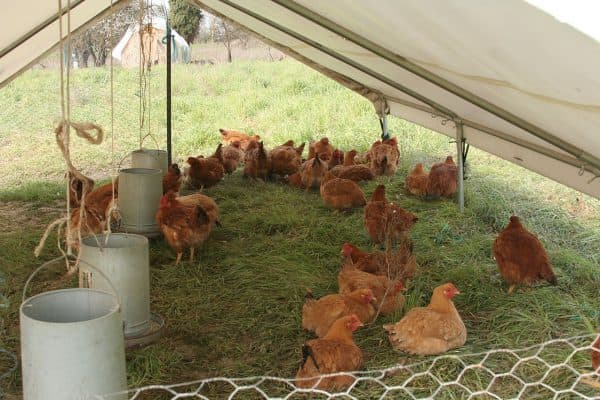

Simple hut-type canopy.
Drinking water should be available both in the containment room and in an open area.
Dominants are hardy and unpretentious to weather conditions, but still severe frosts can be fatal for them. In order for the birds to be warm in winter, the room for keeping them must be insulated. If this breed of poultry is bred in regions where the temperature drops below -10, it is necessary to put heaters in the poultry houses. If there is no ready-made room for breeding chickens, then it must be built with the calculation of one square meter for five birds.
Infrared lamps can be used as heaters in poultry houses. They will emit light and, of course, give the birds the warmth they need to lay eggs. In addition, the risk of colds and death of chickens in severe frosts will decrease.
Laying hens: how to grow at home, food
The maintenance of laying hens is practically no different from other chickens. It can be in open-air cages, cages or free-range areas. It is important that hens receive adequate nutrition. There are various types of compound feed for egg breeds, but if there is no way to buy them, then the nutrition should still be balanced. With the right content and a balanced diet, the dominant egg production will be high. The diet of layers should include the following ingredients:
- Grain (wheat, barley, corn).
- Chopped grass.
- Meat and bone meal, chalk, shell rock.
- Boiled vegetables (carrots, beets, potatoes).
For better assimilation of food, you can put any container with coarse sand or gravel poured into it.
The room for keeping chickens should not be damp. To do this, you need to take care of the preparation of peat and straw for litter from the summer.
It is recommended to keep no more than one rooster in the herd. By attacking one chicken at the same time, they can injure her.
Diseases of the domestic breed
Dominant is a breed of chickens with strong immunity and high resistance to various diseases. Birds of this species rarely get sick. But this does not mean at all that they do not need to be taken care of. In chicken coops, it is always necessary to keep clean, to provide the birds with fresh food. Emerging chickens should be given preventive treatment to avoid the risk of disease in the future. Read about chicken diseases here.
Although chickens of this breed are distinguished by a calm character, it is still necessary to observe them and immediately identify such pathologies as cannibalism in order to protect the livestock from infectious diseases.
Diseases and prevention
Among the ailments that threaten dominant chickens:
- contagious viral diseases of infectious origin: Newcastle disease, avian influenza, candidiasis, avian neurolymphomatosis, laryngotracheitis;
- tumors;
- diseases of a non-infectious nature caused by violation of conditions of detention: skin dermatitis, helminthiasis, the occurrence of downy eaters.
Dominant crosses are unpretentious in maintenance and have strong immunity. Therefore, they are less susceptible to diseases than chickens of other varieties.


Czech breeders claim that compliance with basic hygiene standards, timely vaccination of young animals, treatment of adults in case of suspicion of a viral or parasitic infection, will avoid health problems of dominant chickens.
It is necessary to acquire dominants only through farms with a reputation as reliable producers. Serious breeders, regardless of whether the breed or cross is offered for sale, vaccinate chicks on the first day of life, carefully monitor their nutrition and living conditions, and immediately reject weak birds.
We will be grateful to you for 5 stars and repost the article. Leave comments, share your experience in growing dominant crosses.
conclusions
The breed in the description of chickens dominant (dominant cross) combines several crosses that differ in plumage color. But they all have a number of advantages:
- Unpretentious to the conditions of detention (tricolor, rhodonite, forelock, colored, speckled, sussex). The black subspecies optimally adapts to reproduction and any changes.
- They calmly endure high summer and low winter temperatures.
- Shy, have a calm disposition.
- They have good resistance against diseases characteristic of chickens.
- Good productivity is also determined when growing at home. Up to 300 eggs weighing about 70 grams can be obtained from one layer per year.
- Large weight for oviparous breeds. Males have a weight of about 3 kg.
- The most popular crosses can be identified as: blue, white, black, partridge, sussex.
Also read what breed of chickens to choose for eggs in this material.
Organization of the poultry house
Chickens dominant GS 459 feel great in the southern regions, but they can also withstand a slight frost down to -5 degrees. 4-5 chickens settle on 1 m 2. If there is not enough space, egg production will decrease.
The walls of the hen house are insulated, straw, sawdust or peat 10-12 cm thick is placed on the floor. The litter is cleaned of manure and feathers every day, and is completely changed once a month. Before putting a new one, it is recommended to lubricate the floor with a solution of lime.
In winter, a heater is installed so that the heat in the chicken coop is 12-15 degrees. Humidity should be between 60-70%.
The chicken coop and feeders are disinfected every 1.5-2 months to reduce the risk of spreading infections.


Chicken menu
The dominant GS 459 babies are fed 8 times a day every three hours so that their stomachs get used to food. All products are finely chopped or grated, otherwise the chicks will not be able to swallow them.
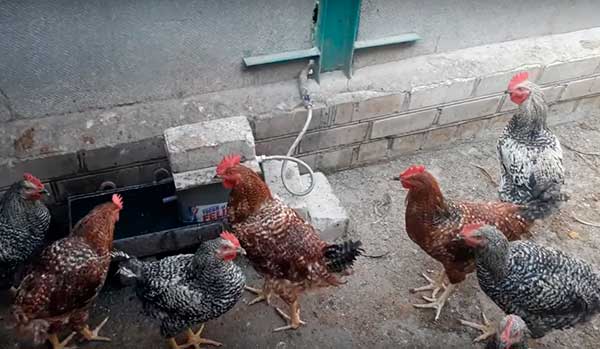

Young animals are fed with dairy products that provide the body with calcium. Fine-grained dry cottage cheese, fresh yogurt or kefir are suitable. They give wheat and corn porridge cooked in broth. The diet must include greens, boiled vegetables, beans. After two weeks, add the fish.
Feeding features
The dominants of GS 459 are unpretentious to food. Chickens are fed three times a day and make sure that there is always fresh water in the drinker.
You can give purchased compound feed for meat and egg production. Or compose a diet yourself.
Chickens dominant GS 459 are fed with a wet mash of bran, vegetables, cereals, cake in meat or fish broth. They enjoy eating whole grains and boiled vegetables.
In the summer, herbs are included in the diet; in winter, grass flour is given instead. In cold weather, food is heated and made more high-calorie so that the chickens do not freeze.

